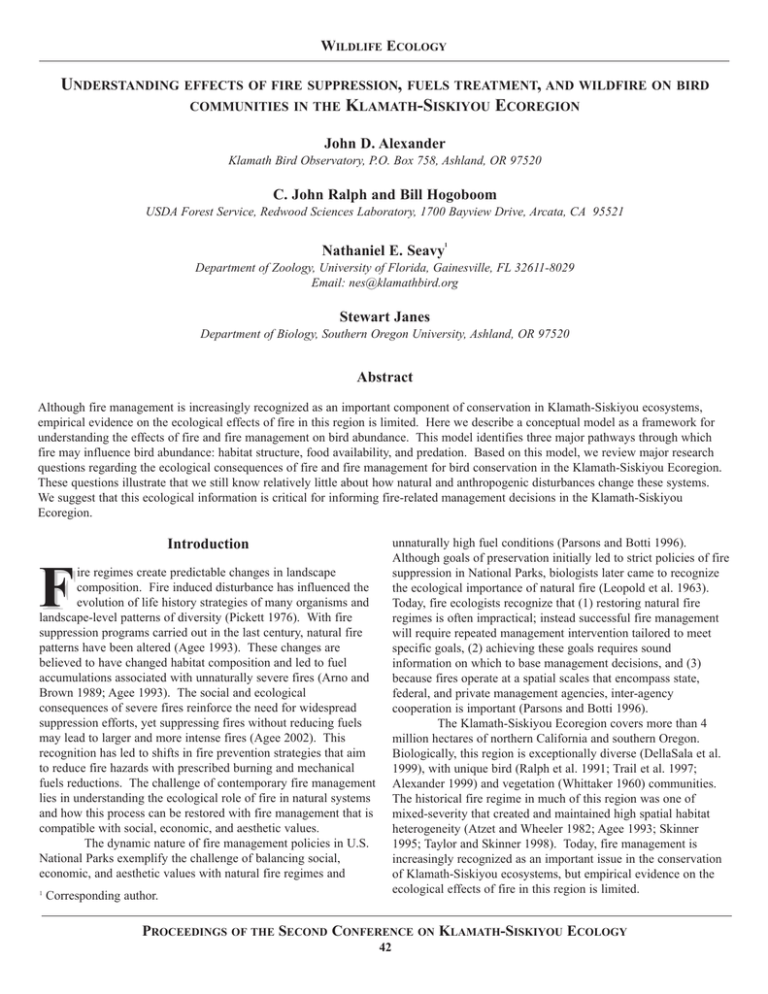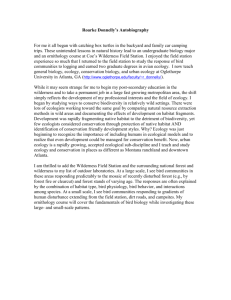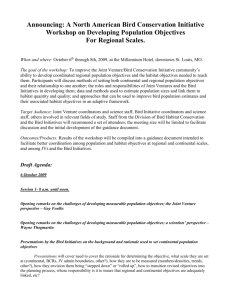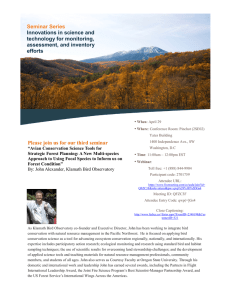U , K -S
advertisement

WILDLIFE ECOLOGY UNDERSTANDING EFFECTS OF FIRE SUPPRESSION, FUELS TREATMENT, AND WILDFIRE ON BIRD COMMUNITIES IN THE KLAMATH-SISKIYOU ECOREGION John D. Alexander Klamath Bird Observatory, P.O. Box 758, Ashland, OR 97520 C. John Ralph and Bill Hogoboom USDA Forest Service, Redwood Sciences Laboratory, 1700 Bayview Drive, Arcata, CA 95521 1 Nathaniel E. Seavy Department of Zoology, University of Florida, Gainesville, FL 32611-8029 Email: nes@klamathbird.org Stewart Janes Department of Biology, Southern Oregon University, Ashland, OR 97520 Abstract Although fire management is increasingly recognized as an important component of conservation in Klamath-Siskiyou ecosystems, empirical evidence on the ecological effects of fire in this region is limited. Here we describe a conceptual model as a framework for understanding the effects of fire and fire management on bird abundance. This model identifies three major pathways through which fire may influence bird abundance: habitat structure, food availability, and predation. Based on this model, we review major research questions regarding the ecological consequences of fire and fire management for bird conservation in the Klamath-Siskiyou Ecoregion. These questions illustrate that we still know relatively little about how natural and anthropogenic disturbances change these systems. We suggest that this ecological information is critical for informing fire-related management decisions in the Klamath-Siskiyou Ecoregion. unnaturally high fuel conditions (Parsons and Botti 1996). Although goals of preservation initially led to strict policies of fire suppression in National Parks, biologists later came to recognize the ecological importance of natural fire (Leopold et al. 1963). Today, fire ecologists recognize that (1) restoring natural fire regimes is often impractical; instead successful fire management will require repeated management intervention tailored to meet specific goals, (2) achieving these goals requires sound information on which to base management decisions, and (3) because fires operate at a spatial scales that encompass state, federal, and private management agencies, inter-agency cooperation is important (Parsons and Botti 1996). The Klamath-Siskiyou Ecoregion covers more than 4 million hectares of northern California and southern Oregon. Biologically, this region is exceptionally diverse (DellaSala et al. 1999), with unique bird (Ralph et al. 1991; Trail et al. 1997; Alexander 1999) and vegetation (Whittaker 1960) communities. The historical fire regime in much of this region was one of mixed-severity that created and maintained high spatial habitat heterogeneity (Atzet and Wheeler 1982; Agee 1993; Skinner 1995; Taylor and Skinner 1998). Today, fire management is increasingly recognized as an important issue in the conservation of Klamath-Siskiyou ecosystems, but empirical evidence on the ecological effects of fire in this region is limited. Introduction F ire regimes create predictable changes in landscape composition. Fire induced disturbance has influenced the evolution of life history strategies of many organisms and landscape-level patterns of diversity (Pickett 1976). With fire suppression programs carried out in the last century, natural fire patterns have been altered (Agee 1993). These changes are believed to have changed habitat composition and led to fuel accumulations associated with unnaturally severe fires (Arno and Brown 1989; Agee 1993). The social and ecological consequences of severe fires reinforce the need for widespread suppression efforts, yet suppressing fires without reducing fuels may lead to larger and more intense fires (Agee 2002). This recognition has led to shifts in fire prevention strategies that aim to reduce fire hazards with prescribed burning and mechanical fuels reductions. The challenge of contemporary fire management lies in understanding the ecological role of fire in natural systems and how this process can be restored with fire management that is compatible with social, economic, and aesthetic values. The dynamic nature of fire management policies in U.S. National Parks exemplify the challenge of balancing social, economic, and aesthetic values with natural fire regimes and 1 Corresponding author. PROCEEDINGS OF THE SECOND CONFERENCE ON KLAMATH-SISKIYOU ECOLOGY 42 WILDLIFE ECOLOGY Considering that the ecological effects of fire are diverse and extensive, monitoring changes in ecological conditions is difficult. Although no single group of organisms can provide a complete picture of the changes caused by fire, birds are recognized as useful and cost-effective tools for ecological monitoring of land management practices (Greenwood et al. 1993; Hutto 1998). Hutto (1998) emphasized that birds are an effective tool for broad-based monitoring because: (1) they are easier than many other vertebrates to identify and less expensive to survey, (2) point-count survey methods quickly collect data on many species, and (3) documenting the response of many species with different life-history characteristics and habitat requirements promotes understanding at the landscape level. Here, we present a conceptual model to describe the influence of fire on bird abundance and then use this model to illustrate the importance of basic research questions for understanding the ecological effects of fire and fire management in the Klamath-Siskiyou Ecoregion. A Conceptual Model of Fire’s Influence on Bird Abundance Our conceptual model of fire’s influence on bird communities describes three major pathways through which fire induced changes may influence bird abundance: habitat structure, predation, and food availability (Figure 1). Perhaps the most obvious effects of fire are changes in habitat structure, such as the reduction in canopy cover or increases in the number of snags. The abundance of many bird species in the Klamath-Sikiyou Ecoregion has been documented to be correlated with habitat structure (Alexander 1999). A simple direct effect of habitat structure on bird abundance may be one of the factors influencing post-fire bird abundance. Additionally, habitat structure may influence bird abundance indirectly if it changes environmental conditions, such as food availability and predation. Variation in bird abundance across habitats has also been linked to food availability (Johnson and Sherry 2001). If insect abundance changes after fire (Abbott et al. 2003), such changes may explain changes in bird abundance. Such an effect may occur independently of changes in habitat structure. Predation, especially on nests, has been documented as a factor influencing bird communities (Martin 1988). If fire changes predation pressure directly (independent of changes in vegetation structure), then this factor should also be considered. Fire Research Questions for the Klamath-Siskiyou Region Information on avian-fire relationships within the Maritime Pacific Northwest has been summarized by Huff and coworkers (in review). This review illustrates that the effects of fire on bird communities in the Pacific Northwest are not well understood. In the Klamath-Siskiyou Ecoregion there have been no studies that specifically address the effect of fire on birds (Huff et al. in review). Thus, our understanding of the ecological process of fire as it relates to bird abundance is rudimentary at best. In order for prescribed fire and other fire management strategies to play an effective role in avian conservation, Huff et al. (in review) identified a number of research and management questions that need to be addressed. Here we present a subset of these questions in the context of our conceptual model and discuss their relevancy to avian conservation in the Klamath-Siskiyou Ecoregion. How does fire suppression affect bird abundance and demographics? Fire suppression may decrease the frequency with which fires burn in low- and moderate-severity fire regimes. When fires become less frequent, fuels may accumulate, potentially altering patterns of fire severity. Such changes would alter the magnitude of the influence fire has on vegetation structure in our model. Such an effect would extend to bird abundance, either directly or indirectly through food availability and predation. The ecological effects of fire suppression in the KlamathSiskiyou are not well understood (Frost and Sweeney 2000), but have probably been greatest at the landscape level (Skinner 1995). Although there have been no studies that directly address how bird communities are affected by habitat changes from fire suppression in the Klamath-Siskiyou Ecoregion, Huff et al. (in review) noted that bird communities most vulnerable to firesuppression induced changes are likely those in low-severity, high-frequency fire regimes (e.g., mixed-conifer, oak woodlands, and chaparral) that are well represented in the Klamath-Siskiyou Ecoregion. Because fire suppression may continue in the Klamath-Siskiyou Ecoregion, the long-term effects on bird communities should be evaluated. How does prescribed fire change conditions for birds? Prescribed fire is increasingly recognized as a potential tool for landscape management. Yet the ability of prescribed fire to create the desired ecological conditions for birds is not well understood (Artman et al. 2001; Jones et al. 2002). In the Klamath-Siskiyou, fires historically occurred in the late summer or early fall (Taylor and Skinner 1998). In contrast, late winter or early spring provide weather and moisture conditions when burns are more easily controlled (Biswell 1989). Because prescribed fire can be applied in many different ways and have many different effects on vegetation structure, food availability, and predation, generalizations are not easily drawn that can be applied widely to birds. Thus, specific studies from the Klamath-Siskiyou Ecoregion may have important management implications for bird conservation. How do fuels treatments affect bird abundance? Although mechanical forest management, (i.e., logging), may produce structural changes similar to natural fire, the effects of these disturbances are not always the same for birds (Imbeau et al. 1999). The ability of mechanical activities to mimic the effects of fire may depend whether or not they replicate food availability or predation conditions that are created by natural fire. As fuels reduction activities are implemented in the Klamath-Siskiyou Ecoregion, these activities should be closely monitored with respect to their effect on bird abundance and demography. PROCEEDINGS OF THE SECOND CONFERENCE ON KLAMATH-SISKIYOU ECOLOGY 43 WILDLIFE ECOLOGY The challenge of understanding the relationship between fuels reduction and bird conservation is illustrated in oak woodland and chaparral habitats of the Klamath-Siskiyou Ecoregion. Because high-severity fires characteristic of these habitats have the potential to cause extensive damage to homes and property, fires are a concern in many of these areas. In an attempt to reduce the landscape risk of fire and maintain habitat characteristics created by fire, the Bureau of Land Management has introduced fuels reduction projects throughout large portions of the Applegate Valley in southwest Oregon. These habitats support a unique bird community, including species such as Acorn Woodpecker (Melanerpes formicivorus), Ash-throated Flycatcher (Myiarchus cinerascens), Wrentit (Chamaea fasciata), and Whitebreasted Nuthatch (Sitta carolinensis). The effects of habitat management on these birds have been addressed by regional Partners in Flight conservation plans (Altmann 2000a). In cooperation with the Medford District of the Bureau of Land Management, we are using these plans to identify desired habitat conditions for oak woodland birds and bird monitoring to compare treated and untreated areas. With this monitoring, the ability of fuels reduction treatments to achieve the desired results for bird conservation can be evaluated. What are effects of post-fire salvage? Post-fire salvage logging removes a range of remaining structure from burned areas. This structure may provide important nest sites and foraging opportunities for many cavity-nesting and bark-foraging birds (Hutto 1995; Kreisel and Stein 2000). Although salvage logging has been hypothesized to have negative consequences for birds that rely on this structure (Hutto 1995; Wales 2001), this effect has not been well documented (Haggard and Gaines 2001). Effects of salvage may interact with burn severity; removing structure from severely burned areas may have much different effects than the same level of extraction from less severely burned areas (Saab and Dudley 1998). Considering the potential for extensive salvage logging operations in the Biscuit Fire of 2002, the ecological effects of this activity deserves more study. The conservation of Klamath-Siskiyou ecosystems depends in part on our understanding of natural fire regimes and related ecological processes. Fire is clearly an important agent of disturbance that influences successional processes and habitat composition in these landscapes. These processes influence landbird species that are dependent on specific habitat attributes created by disturbances such as fire (Brawn et al. 2001). Recently, directives in federal land management agencies have emphasized the need to restore habitats to conditions that are ecologically sustainable. This need is reflected in the fact that current landbird conservation plans and strategies (e.g., Altman 2000a, 2000b) have emphasized collecting information about the effects of fire suppression, fuels treatment, and wildfire restoration on the distribution of fire dependent bird species. There is clearly a need for information from the Klamath-Siskiyou Ecoregion that can be used to understand the role of fire and fire management in landbird conservation and the restoration of ecological processes. Acknowledgments This paper was stimulated by research funded by the Joint Fire Sciences Program, the USDA Forest Service Pacific Southwest and Pacific Northwest Regional Partners In Flight Bird Programs, the Fremont-Winema, Rogue, and Klamath National Forests, and the USDI Bureau of Land Management Oregon State Office and Lakeview District. We are grateful to Mary Rasmussen and Crater Lake National Park for administering this project. Discussions with J. Heinzelmann, D.C. Lee, S. Miller, and M. Widdowson helped develop the conceptual model. Comments on a draft of this manuscript were provided by J. Pagel and an anonymous reviewer. Literature Cited Abbott, I., T. Burbidge, K. Strehlow, A. Mellican, and A. Wills. 2003. Logging and burning impacts on cockroaches, crickets and grasshoppers, and spiders in Jarrah forest, Western Australia. Forest Ecology and Management 174:383-399. Agee, J.K. 1993. Fire ecology of Pacific Northwest forests. Island Press, Washington, D.C. Agee, J.K. 2002. The fallacy of passive management: managing for firesafe forest reserves. Conservation Biology in Practice 3:19-25. Alexander, J.D. 1999. Bird-habitat relationships in the Klamath/Siskiyou Mountains. M.S. Thesis, Southern Oregon University, Ashland. Altman, B. 2000a. Conservation strategy for landbirds in lowlands and valleys of western Oregon and Washington. Oregon-Washington Partners in Flight, Boring, Oregon. Altman, B. 2000b. Conservation strategy for landbirds of the east-slope of the Cascade Mountains in Oregon and Washington. Oregon-Washington Partners in Flight, Boring, Oregon. Arno, S.F., and J.K. Brown. 1989. Managing fire in our forests time for a new initiative. Journal of Forestry 87:44-46. Artman, V.L., E.K. Sutherland, and J.F. Downhower. 2001. Prescribed burning to restore mixed-oak communities in southern Ohio: effects on breeding bird populations. Conservation Biology 15:1423-1434. Atzet, T., and D.L. Wheeler. 1982. Historical and ecological perspectives on fire activity in the Klamath geological province of the Rogue River and Siskiyou National Forests. USDA Forest Service Report, R-6-Range-102. Biswell, H. 1989. Prescribed burning in California wildlands vegetation management. University of California Press, Berkeley. Brawn, J.D., S.K. Robinson, and F.R. Thompson III. 2001. The role of disturbance in the ecology and conservation of PROCEEDINGS OF THE SECOND CONFERENCE ON KLAMATH-SISKIYOU ECOLOGY 44 WILDLIFE ECOLOGY birds. Annual Review of Ecology and Systematics 32:251-276. DellaSala, D.A., S.B. Reid, T.J. Frest, J.R. Strittholt, and D.M. Olson. 1999. A global perspective on the biodiversity of the Klamath-Siskiyou Ecoregion. Natural Areas Journal 19:300-319. Frost, E.J., and R. Sweeney. 2000. Fire regimes, fire history, and forest conditions in the Klamath-Siskiyou region: An overview and synthesis of knowledge. World Wildlife Fund, Ashland, Oregon. Greenwood, J.J. D., S.R. Baillie, H.Q.P. Crick, J.H. Marchant, and W.J. Peach. 1993. Integrated population monitoring: detecting the effects of diverse changes. Pages 267-342. in, R.W. Furness and J.J.D. Greenwood (eds.). Birds as monitors of environmental change. Chapman and Hall, London. Haggard, M., and W.L. Gaines. 2001. Effects of standreplacement fire and salvage logging on a cavity-nesting bird community in eastern Cascades, Washington. Northwest Science 75:387-396. Huff, M.H., N.E. Seavy, J.D. Alexander, and C.J. Ralph. In Review. Fire and birds in Maritime Pacific Northwest. Studies in Avian Biology. Hutto, R.L. 1998. Using landbirds as an indicator species group. Pages 75-92 in, J.M. Marzluff and R. Sallabanks (eds). Avian conservation: research and management. Island Press, Washington, D.C. Hutto, R.L. 1995. Composition of bird communities following stand-replacement fires in northern Rocky Mountain (U.S.A.) conifer forests. Conservation Biology 9:10411058. Imbeau, L., J.-P.L. Savard, and R. Gagnon. 1999. Comparing bird assemblages in successional black spruce stands originating from fire and logging. Canadian Journal of Zoology 77:1850-1860. Johnson, M.D., and T.W. Sherry. 2001. Effects of food availability on the distribution of migratory warblers among habitats in Jamaica. Journal of Animal Ecology 70:546-560. Jones, D.D., L.M. Conner, R.J. Warren, and G.O. Ware. 2002. The effect of supplemental prey and prescribed fire on success of artificial nests. Journal of Wildlife Management 66:1112-1117. Kreisel, K.J., and S.J. Stein. 1999. Bird use of burned and unburned coniferous forests during winter. Wilson Bulletin 111:243-250. Leopold, A.S., S.A. Cain, C.M. Cottam, J.M. Gabrielson, and T.L. Kimball. 1963. Wildlife management in the national parks. American Forestry 69:32-35, 61-63. Martin, T.E. 1988. Habitat and area effects on forest bird assemblages: is nest predation an influence? Ecology 69:74-84. Parsons, D.J., and S.J. Botti. 1996. Restoration of fire in national parks. Pages 29-31 in, C.C. Hardy and S.F. Arno (eds.), The use of fire in forest restoration. USDA Forest Service General Technical Report INT-GTR-341. Pickett, S.T.A. 1976. Succession: an evolutionary interpretation. American Naturalist 110:107-119. Ralph, C.J., P.W.C. Paton, and C.A. Taylor. 1991. Habitat association pattern of breeding birds and small mammals in Douglas-fir/hardwood stands in northwestern California and southwestern Oregon. Pages 379-394 in, L.F. Ruggiero, K.B. Aubry, A.B. Carey, and M.H. Huff (tech. coords.). Wildlife and vegetation of unmanaged Douglas-fir forests. USDA Forest Service General Technical Report PNW-GTR-285. Saab, V.A., and J.G. Dudley. 1998. Responses of cavity nesting birds to stand-replacement fire and salvage logging in ponderosa pine/Douglas-fir forests of southwestern Idaho. USDA Forest Service Research Paper RMRS-RP11. Skinner, C.N. 1995. Change in spatial characteristics of forest openings in the Klamath Mountains of northwestern California, U.S.A. Landscape Ecology 10:219-228. Taylor, A.H., and C.N. Skinner. 1998. Fire history and landscape dynamics in late-successional reserve, Klamath Mountains, California, U.S.A. Forest Ecology and Management 111:285-301. Trail, P.W., R. Cooper, and D. Vroman. 1997. The breeding birds of the Klamath/Siskiyou region. Pages 158-174 in, J.K. Beigel, E.S. Jules and B. Snitkin (eds.). Proceedings of the First Conference on Siskiyou Ecology, Siskiyou Regional Education Project, Cave Junction, Oregon. Wales, B.C. 2001. The management of insects, diseases, fire, and grazing and implications for terrestrial vertebrates using riparian habitats in Eastern Oregon and Washington. Northwest Science 75:119-127. Whittaker, R.H. 1960. Vegetation of the Siskiyou Mountains, Oregon, and California. Ecological Monographs 30:279338. PROCEEDINGS OF THE SECOND CONFERENCE ON KLAMATH-SISKIYOU ECOLOGY 45 WILDLIFE ECOLOGY Figure 1. A conceptual model describing the effect of fire on bird abundance. Fire may change habitat structure, food availability, and predator pressure. In turn, these factors may influence bird abundance through a variety of pathways. Predator density Fire Food availability Habitat structure Predation Foraging success Bird species abundance PROCEEDINGS OF THE SECOND CONFERENCE ON KLAMATH-SISKIYOU ECOLOGY 46




